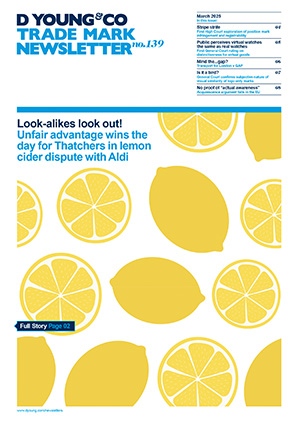Minuty SaS v Miura Brands: earlier mark wins the gold
A mutually shared distinctive element between two marks is enough to cause confusion. The EU Intellectual Property Office (EUIPO) found a likelihood of confusion between ROSE ET OR and OR ONLYROSE.
The applicant, Miura Brands SL, applied for European Union trade mark (EUTM) no. 18848996 for OR ONLYROSE in class 33 (the application). The opponent, Minuty SAS, opposed the application on the basis of a likelihood of confusion with its earlier international registration designating the EU no. 1531007 for ROSE ET OR in class 33 (the “earlier mark”).
Proof of use
An applicant may request that the proprietor of an earlier EUTM who opposes an application, should provide proof of use of that mark during the five-year period preceding the date of filing of the opposed application. Such a request can only be made when an earlier mark has been registered for more than five years at the filing/priority date of the application.
In this case, the filing date of the application was 15 March 2023. Miura Brands requested proof of use of the earlier mark, but, since the earlier mark had not been registered for five years at the relevant date, that request was inadmissible.
Likelihood of confusion
Dealing first with the comparison of the goods, the EUIPO concluded that the application’s alcoholic beverages and cider goods were identical/similar to a low degree to the earlier mark’s wines. In contrast, the application’s remaining goods, namely “alcoholic essences and extracts; alcoholic preparations for making beverages; preparations for making alcoholic beverages”, were considered dissimilar as they are not a finished product for consumers.
The EUIPO considered that the relevant public was the same and that they would have an average degree of attention for the particular goods. The likelihood of confusion assessment focused on the French and Italian speaking part of the public.
Turning to the comparison of the marks, the EUIPO noted that the marks shared the common elements of OR and ROSE. The ROSE element will be understood as indicating the colour and type of wine and so it is non-distinctive for the relevant goods. In contrast, the OR element will be understood as meaning gold and so it is distinctive for the relevant goods.
The differing element of ET in the earlier mark will be understood in French and Italian as a conjunction, so it only has a low degree of distinctiveness (if any), while the application’s ONLY element is meaningless to the relevant public so was held to be distinctive.
The fact that the marks have different beginnings had limited impact on the comparison. As OR was placed at the beginning of the application consumers would pay greater attention to it, and while OR is placed at the end of the earlier mark, as the only distinctive element, consumers would also pay greater attention to it. Given that the only distinctive element of the earlier mark was fully reproduced in the application, the EUIPO concluded that visually and aurally the marks were similar to an average degree. Conceptually, the marks were similar to a high degree as both would be associated with gold and rose.
When assessing the overall likelihood of confusion, the EUIPO concluded that while there are some differences between the marks a likelihood of confusion still existed, as the coinciding element OR played an independent distinctive role in both marks. As it plays a key role in the overall impression, and in how consumers will memorise and recollect the marks, it follows that consumers may be unable to differentiate the marks, particularly given the identity/similarity of the goods and the common element of ROSE.
The application was rejected in relation to “Alcoholic beverages (except beer); cider” and allowed to proceed in relation to the remaining goods.
In short
Even if marks share only a singular element, if that is considered to be distinctive in comparison to the remaining elements, it may be enough to lead to a finding of a likelihood of confusion, particularly in cases where the goods are identical/similar. The case is also a reminder to carefully consider the relevant dates for proof of use, particularly when in relation to international registrations.
Case details at a glance
Jurisdiction: European Union
Decision level: EUIPO
Parties: Minuty SaS v Miura Brands SL
Date: 19 July 2024
Citation: B 3 200 255

